#Jólin
Explore tagged Tumblr posts
Video
Suðurgata Hafnarfirði
0 notes
Text
"Bio, what are you doing?"
listening to "Aleinn um Jólin"
"Bio, it's August 22. Why on Earth are you listening to 'Aleinn um Jólin'?"
because I've lost control of my life
1 note
·
View note
Text
Tonight is the beginning of jólablót for most heathens who observe a lunisolar calendar. The timing is determined by "the first full moon following the first new moon following the solstice." The new moon was immediately after the solstice, making this about as early as a lunisolar jólablót can be.
According to Heimskringla:
Hann setti þat í lögum at hefja jólahald þann tíma sem kristnir menn, ok skyldi þá hverr maðr eiga mælis öl, en gjalda fé ella, en halda heilagt meðan jólin ynnist. En áðr var jólahald hafit hökunótt, þat var miðsvetrar nótt, ok haldin þriggja nátta jól.
'He [King Hákon] made it law to hold Yule at the same time as Christians and each man was to have a measure of ale or else pay a fine, and observe for the duration of Yule. But before, Yule was held on hökunótt, that was midwinter night, and yule was held for three nights.'
Most modern recreation of the lunisolar calendar is built primarily on the work of Stockholm University professor Andreas Nordberg's paper Jul, disting och förkyrklig tideräkning ('Yule, Disting and pre-Christian Time-Reckoning'; paper is in Swedish but with a substantial English summary at the end) though usually not identical to Nordberg's reconstructions. The lunisolar calendar associated with the Nordic Animism movement and the Year of Aun (not exactly the same as Rune Hjarnø Rasmussen's The Nordic Animist Year) is more directly informed by Josh Rood in his paper The Festival Year: A Survey of the Annual Festival Cycle and Its Relation to the Heathen Lunisolar Calendar.
Read more about the Year of Aun, named for the legendary Swedish king who extended his own life by sacrificing his sons, on the Nordic Animism website and on Rune Hjarnø Rasmussen's YouTube channel.
153 notes
·
View notes
Text
The Creatures of Yuletide: The Giant Grýla and her dysfunctional Yule Family
Some days ago, I talked with @ariel-seagull-wings about how Ded Moroz, Grandfather Frost, and his granddaughter Snegurochka, the Snow Maiden, were probably the only holiday figures that were related. I WAS WRONG.
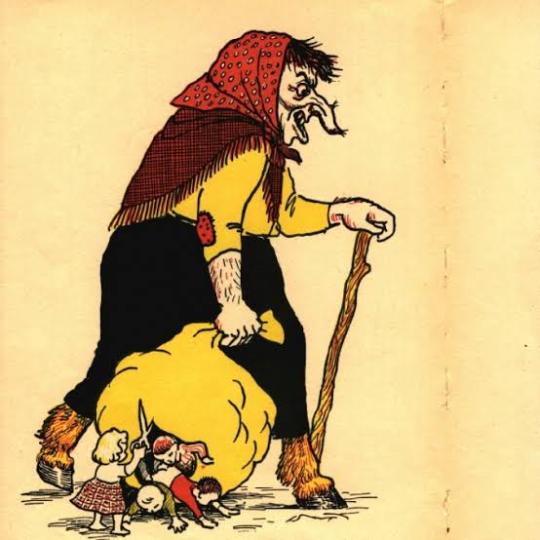
Iceland produced a family so colorful and dysfunctional that it’s a crime there are still no sitcoms based around them. Some members of this family are already famous, others not so much and will have a spotlight today. @thealmightyemprex, my dear, I think you are going to like this family.
Today, we are talking about the giants Grýla and Leppalúði, their yule children, and their giant pet.
Grýla is a giantess said to live in a cave in Dimmuborgir, an area of various volcanic caves and rock formations located in the Myvatn area of north Iceland. Others believe she and her family simply live in an unidentified mountainous area.
Always hungry, she senses the smell of naughty children all year, and during Christmastime, she leaves her cave and comes to cities and towns to haunt them. She collects children in an enormous sack, then brings them back to her cave. There she will cook them in a pot and turn them into a giant stew that will sustain her until the next winter.
Surprisingly, Grýla has been married THREE times, having KILLED her first and second husbands, and EATEN the first. Her third and current husband is the giant Leppalúði. Grýla is often shown beating and berating her husband that is described as being lazy, staying behind in their cave, while Grýla searches for food.
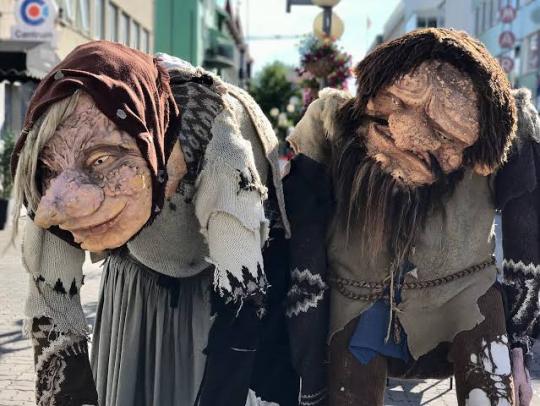
The relationship between Gryla and Leppaludi echoes many villainous couples in sagas and legends from Iceland that were composed of a cruel and bloodthirsty woman with a pathetic, spineless husband.
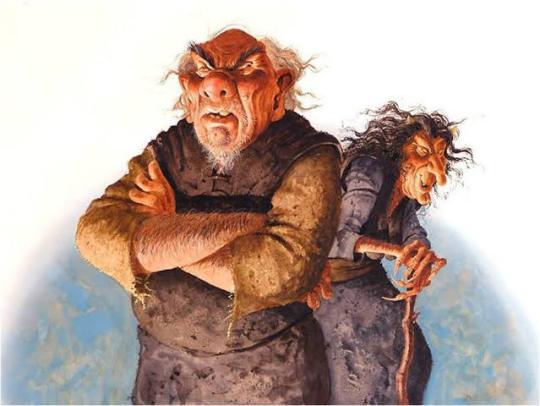
The threat of Grýla was a means to scare children and put them in line, since winters in Iceland were incredibly dangerous, and there was a lot of work that needed to get done before the darkest months set in, requiring effort from all members of the family. It was also a way of protecting children from wandering alone at night, as many disobedient children who went out in the dark and snow never returned home.
Grýla is originally mentioned in the 13th-century compilation of Norse mythology, Prose Edda but no specific connection to Christmas is mentioned until the 17th century.
In the thirteenth century, she was described as having fifteen tails. In the seventh century, she had a hundred bags tied to each tail, with each bag containing twenty naughty children for her pot.
The Yule Lads, are the mischievous offspring between Grýla and Leppalúði. They arrive one by one over the final nights leading up to Christmas, pulling pranks on the humans they find. Originally they were described as being far meaner and more evil, being as monstrous and deformed as their parents, representing the dangers and nuisances of Winter. But by the 18th century, a royal decree about religious practice and domestic discipline banned parents from disciplining their children by scaring them with horror stories of monsters, like Grýla and her family.
By the end of the 19th Century, wealthy merchants began hosting public Christmas tree balls, turning the Yule Lads into friendly old men who brought treats. These versions of the characters first appeared in towns and villages, while their original counterparts survived longer in the countryside. But by the 1930s their transformation had been completed as they begin making regular visits to schools and making appearances on the radio to tell children stories and sing Christmas songs. Today they are gift-bringers like Santa, leaving small gifts in shoes that children place on window sills, but if the child has been disobedient, they leave a rotten potato in the shoe instead.
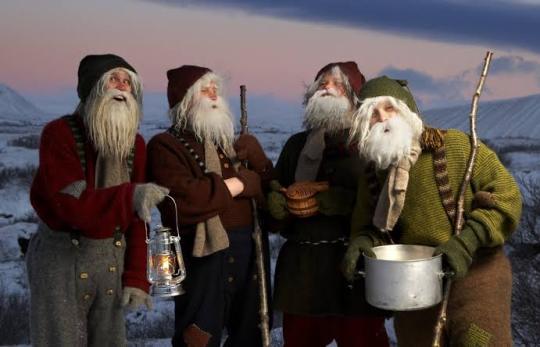
Originally the personalities and number of Yule Lads varied greatly, but thanks to a poem from 1932 by Jóhannes úr Kötlum in the children’s book Christmas is Coming (Jólin koma), still very popular and recited in many Icelandic homes and schools in December, established what is now considered the canonical 13 Yule Lads and their names and personalities.
Here’s the poem, translated by Hallberg Hallmundsson:
Let me tell the story of the lads of few charms, who once upon a time used to visit our farms.
Thirteen altogether, these gents in their prime didn´t want to irk people all at one time.
They came from the mountains, as many of you know, in a long single file to the farmsteads below.
Creeping up, all stealth, they unlocked the door. The kitchen and the pantry they came looking for.
Grýla was their mother – she gave them ogre milk – and the father Leppalúdi; a loathsome ilk.
They hid where they could, with a cunning look or sneer, ready with their pranks when people weren´t near.
They were called the Yuletide lads – at Yuletide they were due – and always came one by one, not ever two by two.
And even when they were seen, they weren´t loath to roam and play their tricks – disturbing the peace of the home.
The first of them was Sheep-Cote Clod. He came stiff as wood, to pray upon the farmer´s sheep as far as he could. He wished to suck the ewes, but it was no accident he couldn´t; he had stiff knees – not to convenient.
The second was Gully Gawk, gray his head and mien. He snuck into the cow barn from his craggy ravine. Hiding in the stalls, he would steal the milk, while the milkmaid gave the cowherd a meaningful smile.
Stubby was the third called, a stunted little man, who watched for every chance to whisk off a pan. And scurrying away with it, he scraped off the bits that stuck to the bottom and brims – his favorites.
The fourth was Spoon Licker; like spindle he was thin. He felt himself in clover when the cook wasn´t in. Then stepping up, he grappled the stirring spoon with glee, holding it with both hands for it was slippery.
Pot Scraper, the fifth one, was a funny sort of chap. When kids were given scrapings, he´d come to the door and tap. And they would rush to see if there really was a guest. Then he hurried to the pot and had a scrapingfest.
Bowl Licker, the sixth one, was shockingly ill bred. From underneath the bedsteads he stuck his ugly head. And when the bowls were left to be licked by dog or cat, he snatched them for himself – he was sure good at that!
The seventh was Door Slammer, a sorry, vulgar chap: When people in the twilight would take a little nap, he was happy as a lark with the havoc he could wreak, slamming doors and hearing the hinges on them sqeak
Skyr Gobbler, the eighth, was an awful stupid bloke. He lambasted the skyr tub till the lid on it broke. Then he stood there gobbling – his greed was well known – until, about to burst, he would bleat, howl and groan.
The ninth was Sausage Swiper, a shifty pilferer. He climbed up to the rafters and raided food from there. Sitting on a crossbeam in soot and in smoke, he fed himself on sausage fit for gentlefolk.
The tenth was Window Peeper, a weird little twit, who stepped up to the window and stole a peek through it. And whatever was inside to which his eye was drawn, he most likely attempted to take later on.
Eleventh was Door Sniffer, a doltish lad and gross. He never got a cold, yet had a huge, sensitive nose. He caught the scent of lace bread while leagues away still and ran toward it weightless as wind over dale and hill
Meat Hook, the twelfth one, his talent would display as soon as he arrived on Saint Thorlak´s Day. He snagged himself a morsel of meet of any sort, although his hook at times was a tiny bit short.
The thirteenth was Candle Beggar – ´twas cold, I believe, if he was not the last of the lot on Christmas Eve. He trailed after the little ones who, like happy sprites, ran about the farm with their fine tallow lights.
On Christmas night itself – so a wise man writes – the lads were all restraint and just stared at the lights.
Then one by one they trotted off into the frost and snow. On Twelfth Night the last of the lads used to go. Their footprints in the highlands are effaced now for long, the memories have all turned to image and song
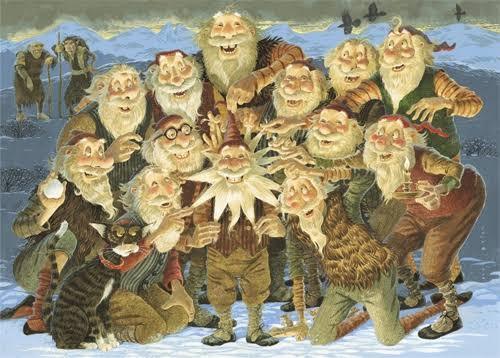
Okay, we have the abusive mother, we have the lazy father, we have the troublemaking sons, but we still haven’t talked about the pet. You know what I’m talking about. I think he’s probably the most famous one in this post, at least outside Iceland. Yes, the Yule Cat is their family cat.
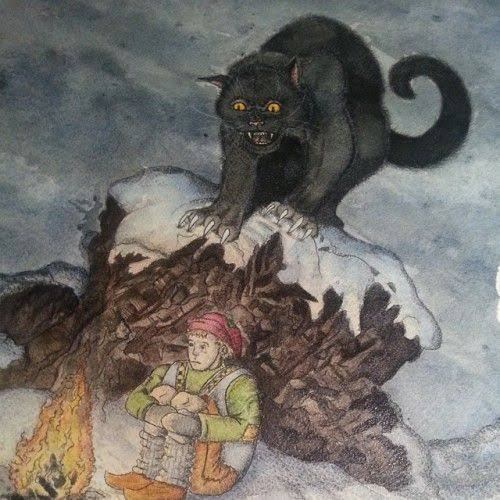
The Yule Cat, Jólakötturinn, is a monstrous giant cat that devours innocent souls that have not received any new clothes to wear before Christmas Eve.
Jóhannes úr Kötlum also wrote about the cat. Here’s the poem, translated by Vignir Jónsson:
You all know the Yule Cat and that Cat was huge indeed.
People didn't know where he came from or where he went.
He opened his glaring eyes wide, the two of them glowing bright. It took a really brave man to look straight into them.
His whiskers, sharp as bristles, his back arched up high. And the claws of his hairy paws were a terrible sight.
He gave a wave of his strong tail, he jumped and he clawed and he hissed. Sometimes up in the valley, sometimes down by the shore.
He roamed at large, hungry and evil in the freezing Yule snow. In every home people shuddered at his name.
If one heard a pitiful "meow" something evil would happen soon. Everybody knew he hunted men but didn't care for mice.
He picked on the very poor that no new garments got for Yule - who toiled and lived in dire need.
From them he took in one fell swoop their whole Yule dinner always eating it himself if he possibly could.
Hence it was that the women at their spinning wheels sat spinning a colorful thread for a frock or a little sock. Because you mustn't let the Cat get hold of the little children. They had to get something new to wear from the grownups each year.
And when the lights came on, on Yule Eve and the Cat peered in, the little children stood rosy and proud all dressed up in their new clothes.
Some had gotten an apron and some had gotten shoes or something that was needed - That was all it took. For all who got something new to wear stayed out of that pussy-cat's grasp he then gave an awful hiss but went on his way.
Whether he still exists I do not know. But his visit would be in vain if next time everybody got something new to wear.
Now you might be thinking of helping were help is needed most. Perhaps you'll find some children that have nothing at all.
Perhaps searching for those that live in a lightless world will give you a happy day and a Merry, Merry Yule.
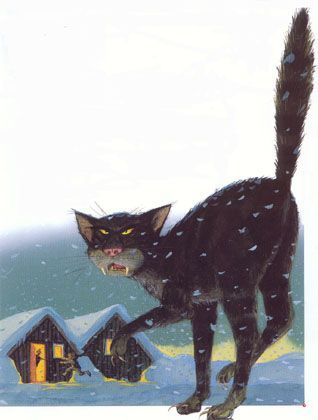
Of all the members of the family, the Yule Cat is the most recent one, with written accounts only as recently as the 19th century. The story was likely created by farmers to ensure their workers finished their weaving, knitting, and sewing by the dead of winter. The reward for those who took part in the work was a new piece of clothing. Those who were lazy received nothing. The Yule Cat was used as an incentive to get people to work harder.
Resuming, we have an abusive mother that haunts and eats naughty children, a spineless father who stays at home all day doing nothing, thirteen rebellious children who seem to have been hanging out too much with Santa, and a giant cat that eats people. I would give anything to see how their Christmas dinners are like.

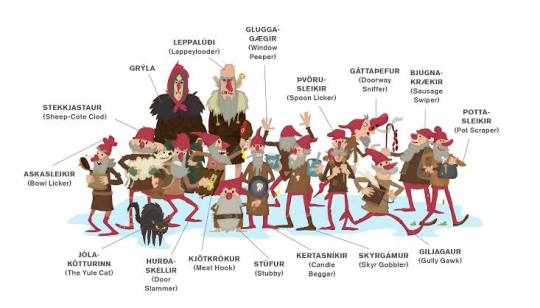
87 notes
·
View notes
Text
lazytown fandom someone tell me the aleinn um jólin AMV is still floating around somewhere... i would like to see it for nostalgic reasons
3 notes
·
View notes
Video
youtube
Langblr Advent Calendar | 7 December 2022 | Last Christmas
Is there a more iconic Christmas song than Wham’s “Last Christmas”? I think not! Fortunately for us language learners, there are also many covers of the song in all kinds of languages. Above is the gorgeous French one by S’arah. There are also versions in:
Swedish: Scotts – Den julen
Spanish: st. Pedro – Last Christmas, Willie Gomez – Last Christmas
Finnish: Timo Mikkonen ja ystävät – Joulusydän
Icelandic: Erna Gunnarsdóttir – Enn jólin
German: Anna Maria Zimmermann – Letzte Weihnacht
Please let me know what your favourite cover of Last Christmas is! I’ve been trying to find one in Chinese or Korean, but so far I’ve had no luck. Every cover I’ve found by Chinese or Korean artists is sung in English.
#langblr advent calendar#langblr#last christmas#french langblr#spanish langblr#swedish langblr#finnish langblr
2 notes
·
View notes
Text

Photo of Stefán Karl as the Grinch, posted by Steinunn Ólína on her Facebook, on the 15th of July 2015: https://www.facebook.com/photo/?fbid=10152783662785834&set=p.10152783662785834
Captioned: Stefan i vinnunni christmas in july! Amerikanar markaðssetja jólin á sumrin.
Translation: Stefan at work Christmas in July! Americans market Christmas in the summer.
#stefan karl#stefán karl#stefan karl stefansson#stefán karl stefánsson#robbie rotten#how the grinch stole christmas#facebook#steinunn ólína þorsteinsdóttir#personal life#2015
2 notes
·
View notes
Text
Kaupa mynd Jólajóla jólatré
Jólasemesterin er að nálgast, og það er tími til að bæta dásamlegum myndum við verkefni þín. Ekki er neitt betra en myndir sem fanga töfra jóla. Hvort sem þú þarft myndir fyrir boð, samfélagsmiðla eða markaðssetningu, þá höfum við allt sem þú þarft.
Safnið okkar inniheldur fjölbreytt úrval af klassískum og nútímalegum jólamyndum. Þú munt finna glæsilega jólatré, snjókoma og hlýlegar stundir með fjölskyldu. Hver mynd hefur verið valin vandlega til að koma á framfæri andrúmslofti og hlýju þessa tímabils, sem gefur þér einstakt tækifæri til að skapa verkefni.
Að finna fullkomna mynd hefur aldrei verið auðveldara. Ef þú ert að leita að hefðbundnu jólatré, snjóbreiðum götum, eða fyndnum augnablikum með Jólasveininum, þá höfum við nóg af valkostum til að hjálpa þér að finna það sem þú þarft. Þú getur leitað eftir lit, stíl eða þema, sem gerir ferlið einfalt og skemmtilegt.
Allar myndir okkar eru í boði í ýmsum sniðum og í hágæða. Það þýðir að þú færð frábærar myndir, óháð því hvernig þú notar þær – frá færslum á samfélagsmiðlum, stórum prentun, rafrænum kortum, til markaðsmats. Myndir okkar munu bæta hátíðarandann við hvert verkefni.
Fjölbreytni jólamyndanna okkar mun gera verkefni þín að sérstökum og skapandi. Frá hefðbundnum stílum til nútímalegra og nýstárlegra hönnunar – við höfum eitthvað fyrir alla. Með því að sameina og blanda saman mismunandi myndum geturðu skapað hátíðarandann sem þú vilt.
Auk þess bjóðum við upp á einstakar og fyndnar myndir sem munu láta þig brosa. Ef þú ert að leita að skemmtilegum augnablikum með Jólasveininum eða friðsælum og rólegum landslagi, þá er safnið okkar fullt af þeim ótrúlegu augnablikum sem munu hjálpa til við að fanga jólaandann.
Við bjóðum ekki bara upp á myndir, heldur einnig þægilegt pallur. Notendur okkar geta leitað, valið og hlaðið niður myndum á aðeins örfáum smellum. Hver mynd fylgir skýrum upplýsingum um leyfi, sem þýðir að þú getur notað þær með fullum trausti í verkefnum þínum.
Ertu að íhuga að kaupa jólamyndir einstaklega? Við bjóðum upp á sérsniðnar þjónustu sem gerir þér kleift að breyta litum, bæta texta og búa til einstaka hönnun sem hentar þínum þörfum. Þetta gefur þér tækifæri til að búa til verk sem endurspegla persónulegan stíl þinn.
Jólin eru líka tími til að deila ást og góðvild. Myndir okkar geta verið fullkomin gjöf. Þetta er frábært tækifæri til að halda sambandi við viðskiptavini, samstarfsmenn og samstarfsaðila með því að senda þeim sérvaldar jólasagnir með frábærum myndum okkar. Að auki geturðu skapað ógleymanlegar minningar fyrir þá sem þú elskar.
Við skiljum mikilvægi þess að stjórna fjárhagsáætlun meðan á hátíðatímabilinu stendur. Þess vegna bjóðum við upp á samkeppnishæf verð og sveigjanlegar kaupmöguleika. Þetta þýðir að þú getur fengið hágæðamyndir án þess að fara yfir fjárhagsáætlun þína. Þú getur keypt eina mynd eða búið til heildarsafn sem hentar þínum verkefnum.
Teymi þjónustu við viðskiptavini okkar er alltaf til taks til að aðstoða þig. Ef þú hefur spurningar um leyfi eða átt í erfiðleikum með að finna fullkomna mynd, ekki hika við að hafa samband við okkur. Við munum veita alla aðstoð sem þú þarft til að tryggja að reynsla þín verði skemmtileg og ánægjuleg.
Myndir okkar eru ekki bara myndir, heldur einnig tilfinningar, hlýja og gleði sem tákna þetta sérstaka tímabil. Með myndum okkar geturðu deilt jólatöfrunum með öllum sem fylgja starfi þínu.
Ekki missa af tækifærinu til að deila jólagleði. Byrjaðu í dag að skoða safn okkar af jólamyndum og finndu fullkomnu myndina fyrir verkefnið þitt. Með fjölbreytni okkar munt þú finna allt sem þú þarft til að skapa ógleymanleg jóla verkefni.
Við bjóðum þig velkomin að skoða safnið okkar og upplifa sköpun og gleði sem hágæðamyndir okkar munu færa. Hvort sem það er persónuleg eða viðskiptaleg markmið – myndir okkar munu hjálpa þér að gera þessa hátíðartímabil enn sérstæðari.
#jól#nýtt ár#frí#jólasveinn#jólatré#vetur#snjór#gjafir#fjölskylda#fólk#börn#bakgrunnur fyrir auglýsingar#áferð fyrir ritstjóra#mynd fyrir markaðssetningu#mynd fyrir markaðssetningu á netinu#sniðmát fyrir ritstjóra#veggfóður fyrir skjáborð#auglýsingar#bakgrunnur#bakgrunnur fyrir markaðssetningu á netinu#veggfóður#skjáhvílur#list#hönnun#mynd#hugtak#skapandi#klippimynd#áferð#límmiði
0 notes
Text
Jól í Latabæ ~ Aleinn um jólin
youtube
Crying my eyes out at this, I've never heard this before...my lonely beloved THIS is why I made Sparkie that way neither of us are EVER alone again...
0 notes
Text

ask and you shall receive!
chi voglio sei tu/þú komst með jólin til mín
youtube
youtube
dopo la tempesta/ég hlakka svo til
youtube
youtube
voulez vous danser/fyrir jól
youtube
youtube
and many more!
fun iceland fact: most contemporary christmas songs here are just stolen italian pop songs with new lyrics
111 notes
·
View notes
Video
youtube
Jólin þín og mín (Mistletoe and Wine in Icelandic)
0 notes
Photo
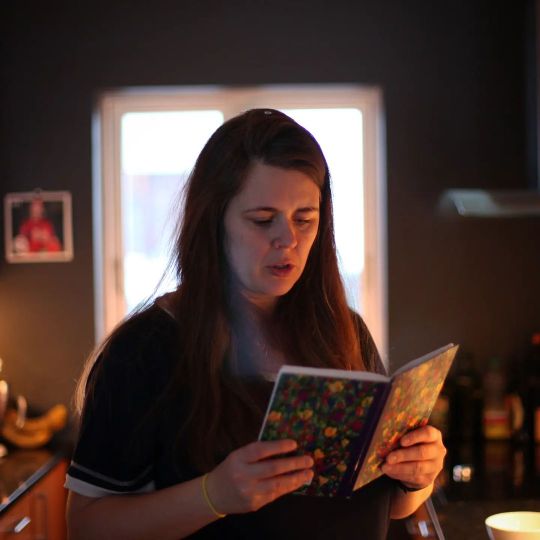
Húslestur að hætti húsfreyjunnar í Flataselinu. Ekki úr Biblíunni eða Aðventu Gunnars Gunnarssonsnar að þessu sinni, heldur er það uppáhald allra á heimilinu og mögulega mest lestna bók ársins... uppskriftabókin 😁 Gæti auðveldlega orðið metsölubók einhver jólin, "Alda eldar - allar uppáhalds uppskriftir sælkerans". https://www.instagram.com/p/Cmr0FKLgWMi/?igshid=NGJjMDIxMWI=
0 notes
Video
Frá Hafnarfirði jólin 2022 by Geir Gunnlaugsson
Hraðinn fyrir jólin
0 notes
Text
You have a dog? Tell me all about him! I'm personally more a cat person but I love dogs too. My friend back in Iceland has a dog. Big and fluffy too, she has to endure the Icelandic winters somehow! And Christmas is definitely the best time to spend with family. In Iceland, we call the festive season Jólin. It spans from November to January and it's personally my favorite time of the year. The lights and the atmosphere of it all is what gets you. Us Icelanders take Jólin very seriously if I do say so myself. I'm totally down to take you if you want!

Spring is probably my favorite of all the seasons — because it means coming out of the freezing cold, which I’m not the biggest fan of. Gotta layer it up cause I feel that so easily. But my dog loves going out into the snow, definitely not like his mama in that regards. Can’t say that I’ve ever been to Iceland before but it does sound magical. Who doesn’t love Christmas? Best time of year to spend with family.

23 notes
·
View notes
Text










Aleinn um Jólin
50 notes
·
View notes
Photo

Digital painting I did of Stefán Karl from the Björgvin’s Christmas Guests (Jólagestir Björgvins) concert, 2017.
Referenced used:

(Video)
#stefan karl stefansson#stefan karl#Stefán Karl#stefán karl stefánsson#lazytown#robbie rotten#glanni glæpur#aleinn um jólin#This is the first time that I was this proud of a painting I did#it actually looked similar to what I had in mind#truly a christmas miracle lmao
69 notes
·
View notes